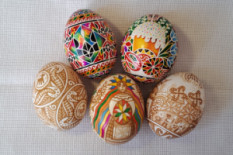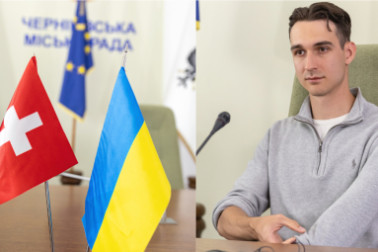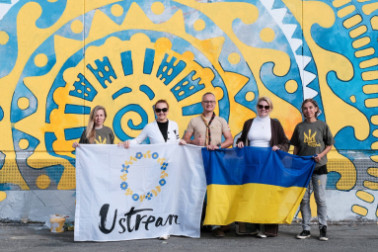There are a lot of paintings in Kostyantyn's office. Actually, it is a small exhibition hall where the exposition is constantly changing. This time, there were paintings by the famous Ukrainian painter Vasyl Nepyypyvo, one of the leading landscape painters of the 20th century, who is called a master of lyrical landscape. Visitors have the opportunity to get acquainted with the diversity of Ukrainian fine art by simply visiting the head of the Union. This is a bonus for all those who visit on business.
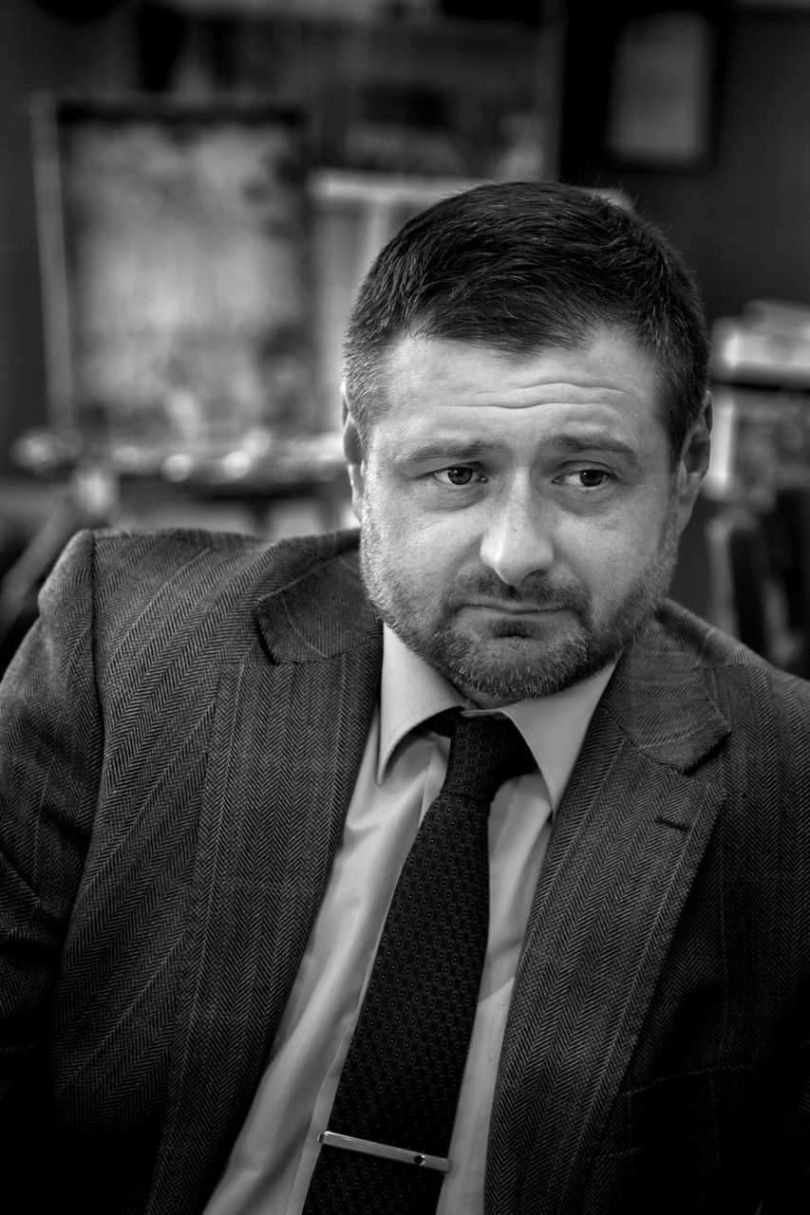
Kostyantyn Chernyavskyi himself is an artist and a representative of a dynasty of artists: both his father and grandfather are famous artists.
So the conversation started with this. As it turned out, this year marks the 100th anniversary of the birth of Heorhiy Chernyavskyi, People's Artist of Ukraine, Kostyantyn's grandfather. And on April 25, a family exhibition dedicated to the anniversary will open at the Art Museum in Dnipro. We invite everyone to attend.
Your path in the profession was determined immediately. You became the successor of the dynasty.
Actually, I had some doubts whether to go into painting or architecture. Because my mother and grandfather on her side, Vsevolod Leonidovich Suvorov, are architects. My grandfather is an honored architect of Ukraine who actually built half of Kyiv.
But in your case, the painting won?
When I was a kid, I used to visit my mother at work and see all these stumps, drawings, and all kinds of architectural tools, but I quickly realized that this was not for me.
I liked the freer life of an artist, and even the smell of paint that had accompanied me since childhood. So painting won, so to speak, by a majority vote.
That's why I entered the State Art School named after Taras Shevchenko, passing the first entrance exam in my life in the fifth grade. It was a conscious choice and the first step for further professional training.
How can you define your artistic style?
Basically, I can characterize myself as an artist of traditional academic principles. For the most part, landscape motifs prevail in my work, and since the beginning of the full-scale war, probably 99% of my work is devoted to the theme of the Ukrainian struggle for freedom and independence.
How has the war affected the community of artists in general?
I communicate with almost the entire artistic community of Ukraine, so I can draw certain conclusions: artists are currently divided in their worldview. For some, the war became a starting point, after which their work changed completely. I probably belong to this category as well. At the moment, I can't realize anything but topics related to the struggle, defense forces, IDPs, and destroyed cities purely psychologically.
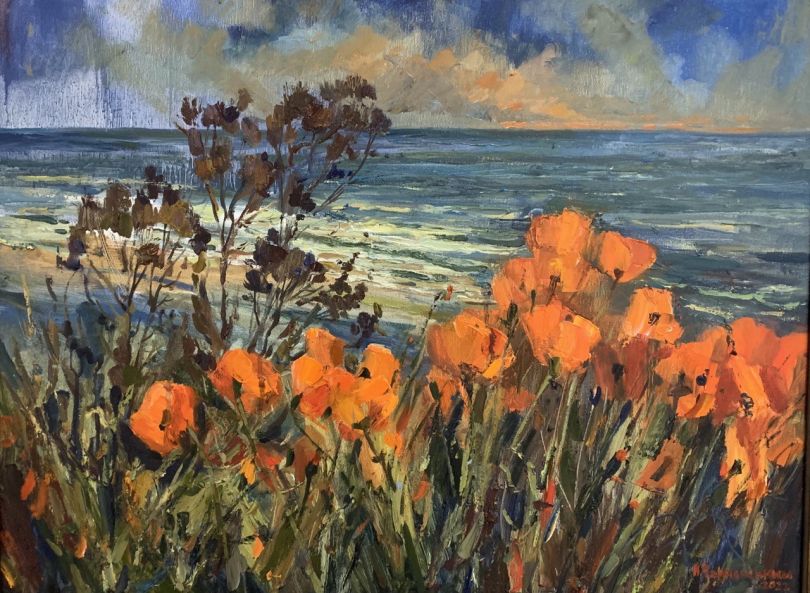
It's such a beautiful spring now, so I went out for sketches, but I couldn't work and just reflect this beauty. So I came back to the studio and continued working on the painting «The Blood of My Azov» dedicated to Mariupol. This city has played and continues to play a very important role in my life, as since 2018 my family and I have actually lived in two cities — Kyiv and Mariupol. I was directly involved in the birth and development of the Mariupol branch of the National Academy of Fine Arts and Architecture. Since the age of 20, I have been the chairman of the examination board of this educational institution and have connected my creative and professional life with this city.
Therefore, the first project of the National Union of Artists of Ukraine during the full-scale invasion was the project «Mariupol — the Soul of Ukraine», which was presented at the Central House of Artists in Kyiv on June 23, 2022.
At that time, our exhibition halls were attended by perhaps the largest number of viewers ever. It was not just an exhibition, but a cultural and artistic project together with the National Academic Orchestra and Folk Instruments of Ukraine (NAOFI).
The event was very publicized also because it was organized jointly with the Ministry of Defense and the Ministry of Culture and Information Policy, with whom we work very closely. We have a lot of joint projects at the state level that are aimed at working on the so-called cultural front.
You said that artists are divided in terms of the impact of the war on their work. How does the other part react?
For example, when we tried to involve different artists of very different directions in the project «Unconquered Hero Cities» or invited them to work on the armed forces, many of them said that they could not work with this now... They just can't.
We are all currently experiencing traumatic experiences, but each of us lives it in our own way.
Was Mariupol the first city in the Unconquered Hero Cities project?
This project began with the exhibition «Mariupol — the Soul of Ukraine», which later transformed into «Unconquered Mariupol». It was presented outside Ukraine. The first presentation took place in Gdańsk (Mariupol's sister city), Warsaw, and then in the Baltic States.
Currently, the project is being presented in various cities in Germany, and then it is planned to be shown in the Scandinavian countries and on other continents.
The project is non-profit, as we want to show the tragedy of Mariupol to as many countries as possible. Of course, there were offers to buy the works. So we held auctions under the patronage of our (Union of Artists of Ukraine — ed.) International Charitable Foundation to raise funds for the needs of the Armed Forces and IDPs. Both in Europe and in Ukraine.
The project about Mariupol is, let's say, the first swallow of our big project. At the end of the 22nd year, we were approached by the Ukrainian Cultural Foundation with a proposal to organize an exhibition «Kherson Region is Ukraine». At the time this idea began to emerge, Kherson was still occupied.
The exhibition was held at the Central House of Artists. Imagine: December, blackout, cold, dark, but the exhibition was held with great moral uplift. Moreover, at that time the city of Kherson was already de-occupied. Then the exhibition was exhibited in different cities of Ukraine, and then in Luxembourg. All the participating artists provided their works free of charge. 100% of the proceeds from the sale of the paintings went to the needs of the affected residents of Kherson. And it turned out to be a very successful project in terms of fundraising.
After that, we came up with the idea of a large-scale all-Ukrainian project, «Unconquered Hero Cities».
We wanted to show exhibitions in cities that had either been de-occupied or were in a zone close to hostilities. We started with the exhibition «Kryvyi Rih - The Iron Heart of Ukraine», which was presented in April 2023 in the city of Kamianske, Dnipro region, because it was there that we received permission from the military administration. There was also a show in Kryvyi Rih, but a little later.

Does the exhibition include only contemporary works or also paintings from the past?
These are the works of our contemporaries, mostly artists from the cities to which the project is dedicated. This is very valuable. For example, many artists from Mariupol have nothing left, and for an artist, it is extremely painful not so much to lose an apartment as to lose a studio and works. And the opportunity to create and show new works is of great importance to artists. In addition, many of them have personal experiences that they gained during the war and can share. This makes the works even more valuable.
What other cities are featured in the project?
The next city was Mykolaiv — on August 15, 2023, we inaugurated the project «Mykolaiv Unconquered».
I want to note that the exhibition hall in which we were to showcase the project was damaged by more than 6 arrivals (it is how a hit by a missile, a drone, etc. is called in Ukraine). One of them took place 10 days before the opening date. However, through joint efforts, the hall was brought to a state that allowed the presentation to take place. It was the first cultural event since the beginning of the full-scale invasion. And as representatives of the Department of Culture, city and regional authorities noted, we had half the city gathered.
Then we implemented a project about Chernihiv. But after a terrible tragedy happened on August 23, when Russians shelled the city center, damaged the drama theater, and many people were injured, we had to postpone the presentation. Our exhibition space, the Museum of Contemporary Art, is located 500 meters from the damaged theater.
But in the end we managed to realize our plan. It was powerful. And we realized that the city really needed it.
(On the days when the interview was being prepared, there was another hit in the center of Chernihiv and a day of mourning for the victims.)
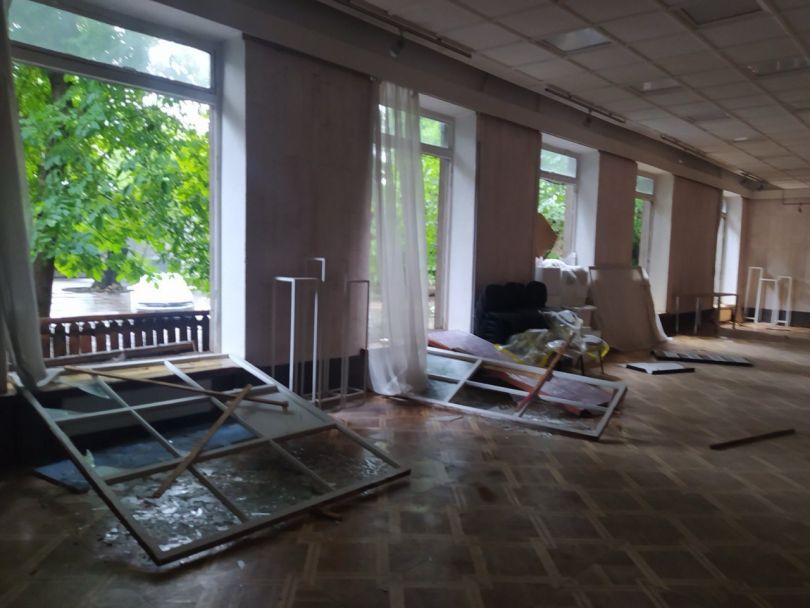
For our artists, these projects are extremely meaningful. It is important for them when people come and thank them.
And at the end of April 2023, the Kharkiv Art Museum hosted a solo exhibition of our colleague, People's Artist of Ukraine Viktor Kovtun, who has not left Kharkiv for a single day since the beginning of the full-scale invasion and has created more than 180 works, chronicling the war and defense of Kharkiv.
In this heroic city, we were not allowed to work for a long time, as in other cities. But in the end we succeeded, although the exhibition was open only a few hours a day.
In May, we plan to present the project «Unconquered Hero Cities» in Kyiv at the Central House of Artists.
I also want to tell you about one more important and interesting project, «Moshchun — An Unhealed Wound». It is about the small village of Moshchun in the Kyiv region, which was the first settlement to be liberated from the occupiers. As of today, more than 85% of the houses remain destroyed. People are living in inhumane conditions. And, and this is a reproach to the authorities, nothing is being done, just nothing.
At the end of November 2023, the International Foundation «Let the World Know Ukraine», President of the Foundation Roman Malyarchuk, organized En plein air «A Powerful Man — An Unhealed Wound» together with the National Union of Artists of Ukraine as part of the TOLOKA Global Community project. And on New Year's Eve, they presented their works in the restored Palace of Culture in Hostomel. It was both an exhibition and a concert dedicated to Moshchun. The main idea of the cultural and artistic event is to draw the attention of both the Ukrainian and international communities to the problem of rebuilding a small village in the Kyiv region, which actually shielded the capital of Ukraine from enemy invasion.
But we are not stopping, now my dream is to hold an exhibition in a city that is as close as possible to the war zone, and it is already scheduled for August 2, 2024, in Shostka, on the border of Sumy region. The project will be called «Unconquered Borderland». Preparations are underway, and we hope that the security situation will allow us to realize it.
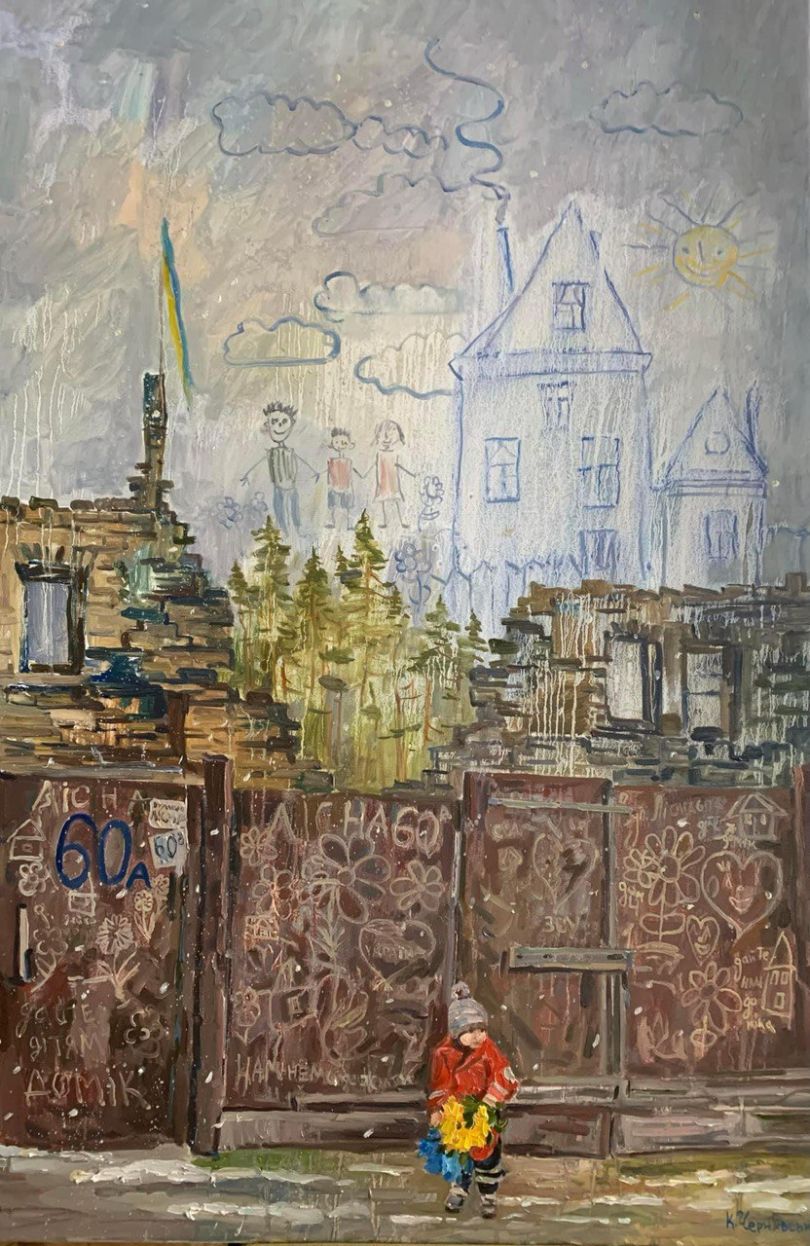
Did you experience any special interest in Ukraine during your exhibitions abroad?
Given that it was back in '22, of course, the exhibitions caused a great deal of excitement. Now the interest is starting to fade a little bit. Let's be honest, everyone is tired of the war. And now we are being offered to do joint international projects, but everyone has one condition: no war. Europeans do not want to see suffering. Especially after the Oscar-winning film 20 Days in Mariupol, which many people have seen.
Therefore, I, as a project organizer, and others, refuse to participate. We are not interested in it now.
But thanks to our International Charitable Foundation, we cooperate with many foreign donors and Ukrainian foundations and try to support the Armed Forces of Ukraine, our colleagues who have been left without a livelihood. As well as IDP children.
Did you have a personal exhibition this year?
Yes, in March of this year I had an exhibition at the AVS gallery with a rather symbolic title «Land Not for Sale».
The fact is that this exhibition was scheduled for the fall of '22 at the Kuindzhi Art Museum in Mariupol, but all the works were destroyed. In Kyiv, photographs of those works were presented, as well as more than 50 paintings created over the past three years.
So you also lost a lot in Mariupol?
Compared to my other colleagues, there are not so many lost works — about 10 works that were dedicated to Mariupol and written there. But they were very precious to me. In general, there are a lot of artistic losses in Mariupol. Now, after Alla Horska's exhibition, everyone has learned about the beautiful mosaics of Mariupol, which were also destroyed.

Why is this city valuable for Ukraine in the artistic sense? After the tragedy of Mariupol, we suddenly realized how many cultural and artistic monuments there were. We didn't know about it...
It was a real European cultural city. Every 5 years, the Arkhip Kuindzhi Memorial International Art Festival was held there. In 2021, a large-scale event took place, which was attended by representatives of more than 30 countries. Today, the Kuindzhi Center for Contemporary Art is completely destroyed, with nothing left. And the Kuindzhi Art Museum was hit by a bomb, although the building more or less survived. But everything in the collections was taken first to Donetsk, then to Russia. It is not known for certain whether the original works by Kuindzhi were there. According to one version, several small sketches by Kuindzhi were original and were stolen.
And besides, there was a fantastic ethnographic museum in Mariupol with amazing collections. However, the director turned out to be a collaborator and prepared everything so that absolutely all the funds, all the storerooms, were taken away by the occupiers. She fled to Russia.
Well, the tragedy of the Mariupol Theater is known all over the world. Many of our artists addressed the tragedy of the Mariupol Theater.

Art does help both artists and viewers cope with difficult experiences.
Yes, it does. In general, art therapy is a very large percentage of our work. We cooperate with the Central Clinical Hospital, where we have been conducting art therapy for wounded soldiers for two years in a row. Recently, we held an exhibition of soldiers' works. Of course, these are amateur works, but they are painted with heart and soul under the guidance of professional artists.
And on May 9, we plan to open a joint project with the Institute of Contemporary Art Problems of the National Academy of Arts, called «Arti-Art», which was started by our colleague, an artillerist of the Armed Forces of Ukraine and an employee of the institute, Antin Kolomyiets. We plan to expand the project to show the war from all sides, because it is everywhere. We can't get away from it, and we will work as long as necessary to win.
Regarding the issue of influence on the world. How interesting are the works of Ukrainian artists outside the country?
Of course, we are interesting because we have preserved our professional school. This is something that doesn't exist in other countries, at least if we're talking about Western Europe. However, for example, before the start of the full-scale war, Ukraine was not a member of the International Association of Artists' Unions IAA EUR. Almost all post-Soviet countries located in the European part were represented there, but we were not. Our predecessors considered it inexpedient, including because of the need for a regular contribution of 900 euros per year.
And so, on April 21, 2022, we held a large-scale conference with representatives of the Association. Our demand was that Russia and Belarus be stripped of their membership. And we won: the membership of the aggressor countries was suspended, and we joined the community. Now it is especially important because every European country has a representative office of the Association, where our refugee artists, mostly women and older artists, can apply and receive support: a membership card that gives them free access to all European museums (a significant saving for refugees), assistance in socialization, and even orders.
Such powerful support from the artistic community!
It is very important. Our colleagues are even selling their works. But the most important thing for them is that they are known as artists, they are not just refugees living in a reservation somewhere, but members of the artistic community.
By the way, we are planning to open our own platform in Switzerland and Portugal — an art residence where our women artists or older men could go on the terms of the host country. The idea is to psychologically rehabilitate our artists and give them the opportunity to work in a safe place.
Currently, our representative is in Switzerland, and we hope that this center will start working very soon.
Ukrainians are now more actively studying their own culture and history. Do you notice these trends? That people are interested in Ukrainian artists, not just the conventional Repin. Even though Repin is Ukrainian.
Repin is a Ukrainian artist, and this has already been recognized by the Metropolitan Museum of Art. As for the interest, yes, it is noticeable. The last large-scale exhibition of Alla Horska's works, Boreviter, caused a great deal of resonance. We all see how much people need it. And our project «Unconquered Hero Places» also demonstrates this.
And in Europe, our school is valued, often noted for its high professional level, even when we bring student work that we ourselves consider far from excellent.
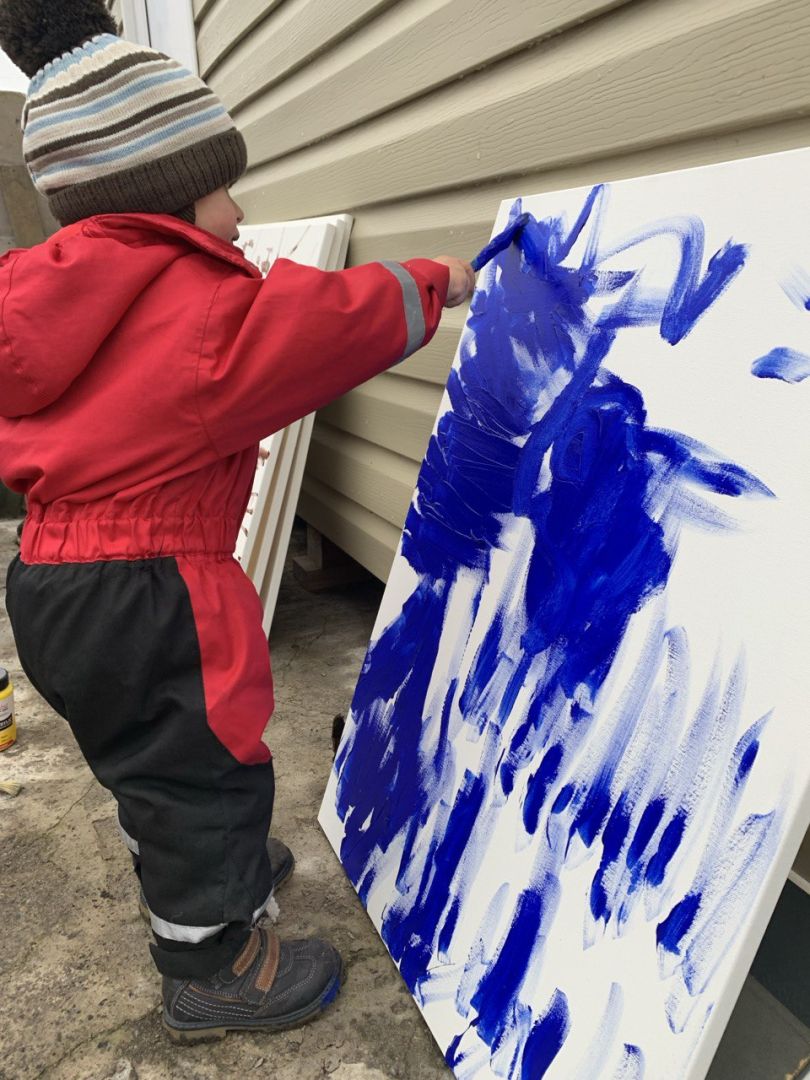
And finally, if you were asked to name 5 artists who could represent Ukraine, who would it be?
This will be my subjective vision. I'm a painter, so I'll name artists of this art form. I can't imagine Ukrainian painting without Mykola Hlushenko, Serhiy Shyshko, Anatoliy Kryvolap, our contemporary Viktor Sydorenko, who is an extraordinary professional who can create both mega-realistic works and find interesting conceptual solutions.
If we talk about the classical school, it's the Kharkiv School — Viktor Kovtun, Yuriy Vintayev. And also Zhana Kadyrova, a painter and sculptor who represented Ukraine at the Venice Biennale.
Our art is also valuable because it is very different. For example, if we talk about representatives of folk art, we cannot but mention Maria Pryimachenko, Kateryna Bilokur, and representatives of the Boychukism movement...
In general, we have a lot to be proud of and to show the world.
